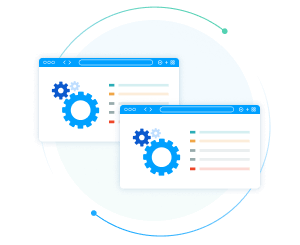What is an API Connector? Use Cases & Differences with Data Connectors

In 2022, ProgrammableWeb reported that there were 24,000 public APIs (application programming interfaces), providing programmatic access to a variety of services and applications. With all these APIs, organizations need a way to ease the burden of IT teams while getting continuous access to the data stored in the applications.
In this article, we'll explore API connectors' roles, functions, and distinctions from traditional data connectors, highlighting the capabilities and practical use cases of API connectors and providing insights on custom data connectivity.
What is an API connector?
An API connector is a software library, tool, or platform that facilitates the programmatic access to systems provided by APIs. API connectors make it easier for IT teams, developers and other data consumers to access the data behind APIs.
API connectors work by translating the request coming from the data consumer into the API for the underlying system. The connector handles everything about working with the API, including authentication, pagination, and, if the API is a REST API, the connector processes both read and write commands, converting them to the appropriate GET, PUSH, POST, or DELETE command. When the API returns data, whether it is as a CSV document, JSON response, or something else entirely, the API connector transforms it into a format that can be processed by the data consumer.
What is the difference between an API and an API connector?
The biggest differentiators between APIs and API connectors are the scope and application. APIs are a general concept and can refer to any interface between software systems and applications, a language or set of rules for communicating with a system. An API connector is a tool that takes advantage of APIs. It implements the rules for the API and often adds additional features like graphical user interfaces to help users integrate different systems.
Examples of API connectors
As we've discussed, an API connector is a software library, tool, or platform that makes it easier to work with APIs Below, we share a few examples API connectors, from developer-centric libraries to full-featured software platforms.
- Data Connectors: Software libraries written to meet connectivity standards (JDBC, ODBC) or other protocols allow for a variety of custom-built and self-contained applications to connect with data through APIs. By wrapping a familiar set of rules around the APIs, these connectors enable self-service connectivity for software engineers, data engineers, data scientists, and more.
- CData Connect Cloud: A cloud-based data connectivity platform, CData Connect Cloud links dozens of applications to a broad ecosystem of real-time data sources through consistent, standards-compliant interfaces. It acts as a single point of contact for all of your APIs, enabling consolidated access, governance, and management.
- Zapier: Zapier is a powerful tool that allows users to automate workflows by connecting over 3,000 web apps. For example, it can connect an email marketing platform like Mailchimp with a CRM like Salesforce, automating the process of adding new leads from Salesforce to a Mailchimp mailing list whenever a new lead is created.
- MuleSoft's Anypoint Platform: MuleSoft offers an integration platform for connecting SaaS and enterprise applications in the cloud and on-premises. An example of its use could be connecting a company's internal HR system with LinkedIn to streamline the recruitment process. This allows automatic retrieval and update of job candidate profiles and statuses between the two platforms.
- Microsoft Power Automate (formerly Microsoft Flow): This service helps users to create automated workflows between Microsoft applications and other services to synchronize files, get notifications, collect data, and more. An example usage would be automatically saving email attachments from Microsoft Outlook to OneDrive or SharePoint.
- IFTTT (If This Then That): IFTTT enables users to create conditional statements, called applets, which connect different services and devices. For instance, you could use an IFTTT applet to automatically post your Instagram photos as Twitter photos, not just as links, by connecting the Instagram and Twitter APIs via the IFTTT platform.
Each of the connectors above abstract away the complexity of dealing with APIs and provide a more user-friendly way to build integrations, customize workflows, automate tasks, and connect different software and services.
API connectors and integrations
When it comes to integrating various software systems, API connectors play a pivotal role. Their functionality can be highlighted through several key aspects:
- Endpoints: API connectors interact with specific endpoints of an API, which are URLs representing objects or actions within a system. By doing so, they facilitate the access and manipulation of data across different platforms.
- Authentication: API connectors handle the authentication process required by APIs, often involving tokens or API keys. This ensures that the connection and data exchange between systems are secure.
- CRUD actions: API connectors support create, read, update, and delete (CRUD) actions, which are fundamental to interacting with data. This capability allows for the full spectrum of data management through integrations, from adding new records to retrieving and updating existing data, and finally, deleting data when necessary.
API connectors are invaluable tools in the modern API ecosystem, offering streamlined, efficient pathways for integrating diverse software solutions. By handling complex integration tasks, they empower developers and businesses to focus on creating superior user experiences and innovating within their core competencies.
CData Connect Cloud universal API connector
While CData Connect Cloud has an extensive library of pre-built API connections, custom engineered to maximize functionality with the given API, it also features a universal API connector. The CData API connector streamlines analytics and reporting by effortless modeling any API as a data table for easy consumption, as well as providing code-free integration to facilitate connecting with public and private (cloud-facing) APIs.
If you haven't already, join our CData Community where you can continue your data journey with like-minded data professionals!
Try CData Connect Cloud
Sign up for a free trial of CData Connect Cloud and connect to your favorite API from your preferred tools and applications today.





